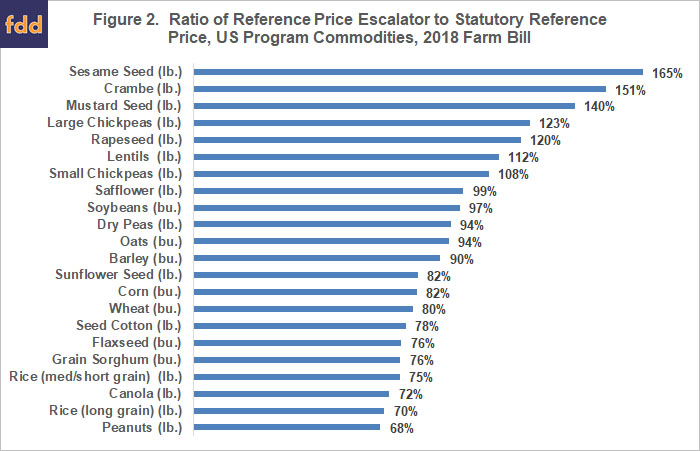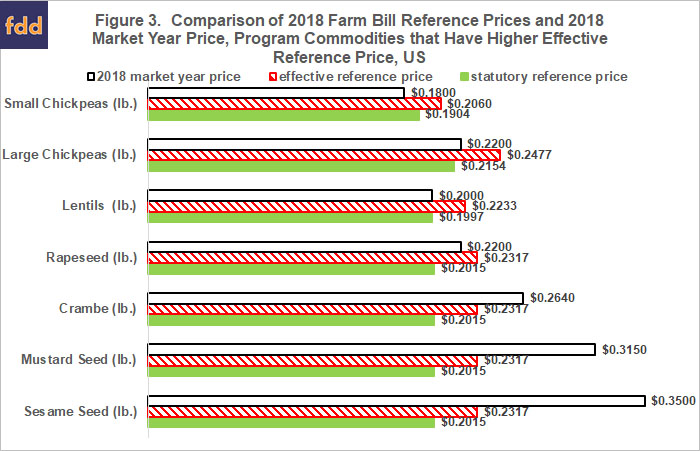2018 Farm Bill Reference Price Escalator for 2019 Market Year
The Agriculture Improvement Act of 2018 (2018 farm bill) has an escalator option for the reference price used to calculate ARC and PLC payments. Effective reference price equals the higher of (a) statutory reference price (reference price stated in farm bill) for the covered commodity or (b) escalator option of 85% of the Olympic average price of the covered commodity for the 5 most recent crop years (excludes high and low price), but (c) cannot exceed 115% of statutory reference price. This article contains an analysis of this 2018 farm bill provision for the upcoming 2019 crop year.
Data and Procedures
Statutory reference price and 2014-2018 market year average prices used to calculate the price escalator are from the US Department of Agriculture, Farm Service Agency website. There are 23 program commodities. However, the reference price for temperate japonica rice equals [effective reference price for long grain rice) times (ratio of average 2012-2016 market year price of medium grain rice to average 2012-2016 market year price of all rice)]. The price escalator provision is thus effectively the same for temperate japonica and long grain rice. Since the 2018 crop year is on-going; its market year price is the current estimate as of February 8, 2019. See Data Notes 1 and 2 regarding market year price for medium/short grain rice and seed cotton.
Statutory Reference Price
Figure 1 presents statutory reference prices for 22 program commodities. The unit in which price is quoted is in parenthesis.

Reference Price Escalator
The reference price escalator is calculated for the 2019 market year using the farm bill formula and market year prices for 2014 to 2018. Figure 2 presents the reference price escalator as a ratio to the statutory reference price. The ratio ranges from 68% for peanuts to 165% for sesame seed. A ratio above 100% implies the program commodity is currently expected to have an effective reference price that is greater than the statutory reference price for the 2019 market year. A ratio less than 100% implies the program commodity is currently expected to have the statutory reference price. Effective reference price can change each year since the calculation window changes. For example, the window for the 2020 market year will be the 2015-2019 market years.

Higher Effective Reference Prices
Based on currently available information the effective reference price is expected to exceed the statutory reference price for crambe, large and small chickpeas, lentils, mustard seed, rapeseed, and sesame seed. The increase is capped at 115% for all but 2 of these program commodities (lentils and small chickpeas). This cap is reflected in Figure 3. Also presented in Figure 3 is the current estimate of 2018 market year price. Making the simple assumption that 2019 market year price will be 2018 market year price, the reference price escalator will result in higher PLC (Price Loss Coverage) payments for lentils, rapeseed, and large and small chickpeas but not for crambe, mustard seed, and sesame seed. Payments are not expected for the latter since expected market year price exceeds their effective reference price.

Summary Observations
- Based on current information, crambe, large and small chickpeas, lentils, mustard seed, rapeseed, and sesame seed are likely to have higher reference prices for the 2019 market year due to the reference price escalator provision in the 2018 farm bill.
- However, it currently appears likely crambe, mustard seed, and sesame seed will not receive PLC payments as market year price is likely to exceed even their higher effective reference price.
- Thus, the 2018 farm bill reference price escalator does not fully address the payment difference that arises among the minor oilseeds from using a single reference price for them despite widely different market prices (see May 31, 2018 farmdoc daily article for discussion of this issue).
Data Notes
- Medium/short grain excludes temperate japonica rice.
- Seed cotton price is a weighted average of upland cotton and cottonseed prices. The 2018 market year for upland cotton and cottonseed are, respectively, August 1, 2018 to July 31, 2019 and August 1, 2018 to February 28, 2019.
References
US Congress. 115th Congress. December 2018. Agriculture Improvement Act of 2018. https://www.agriculture.senate.gov/imo/media/doc/CRPT-115hrpt1072.pdf
US Department of Agriculture, Farm Service Agency. February 15, 2019. “ARC/PLC Program Data – Program Year 2018 Data.” https://www.fsa.usda.gov/programs-and-services/arcplc_program/arcplc-program-data/index
Zulauf, C., J. Coppess, G. Schnitkey and N. Paulson. "A Policy of First among Equals – The Case of PLC and “Other Oilseeds”." farmdoc daily (8):99, Department of Agricultural and Consumer Economics, University of Illinois at Urbana-Champaign, May 31, 2018.
Disclaimer: We request all readers, electronic media and others follow our citation guidelines when re-posting articles from farmdoc daily. Guidelines are available here. The farmdoc daily website falls under University of Illinois copyright and intellectual property rights. For a detailed statement, please see the University of Illinois Copyright Information and Policies here.







